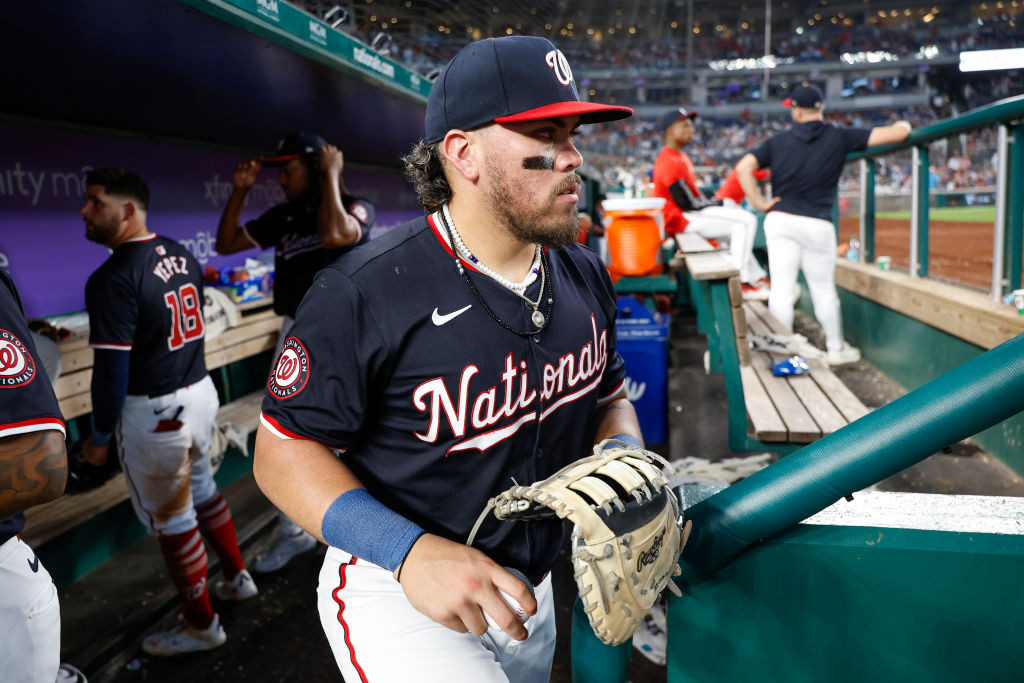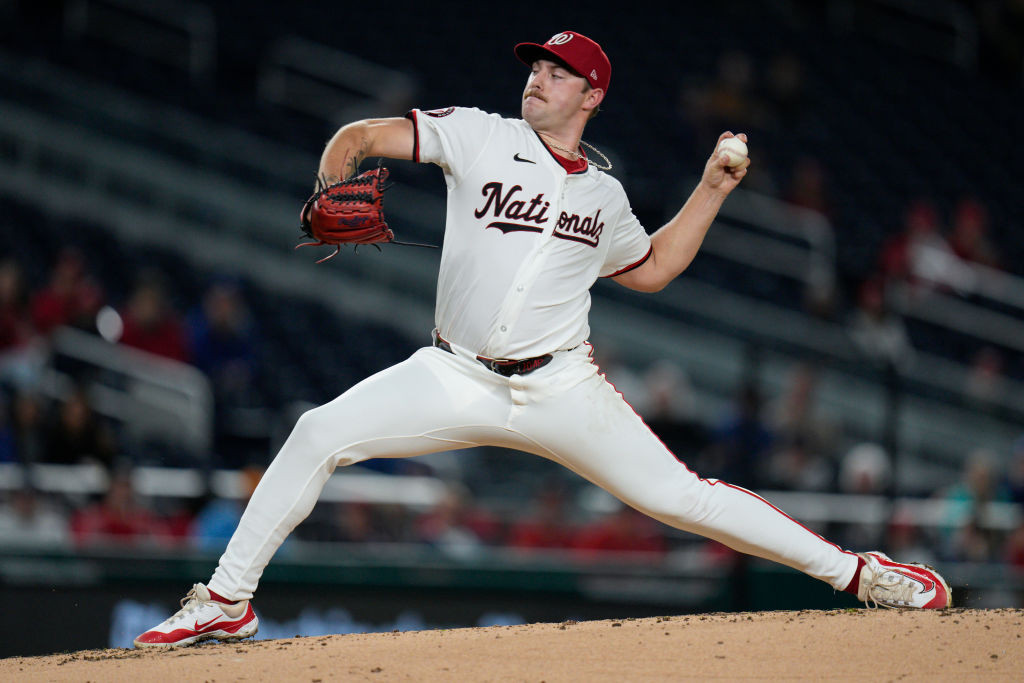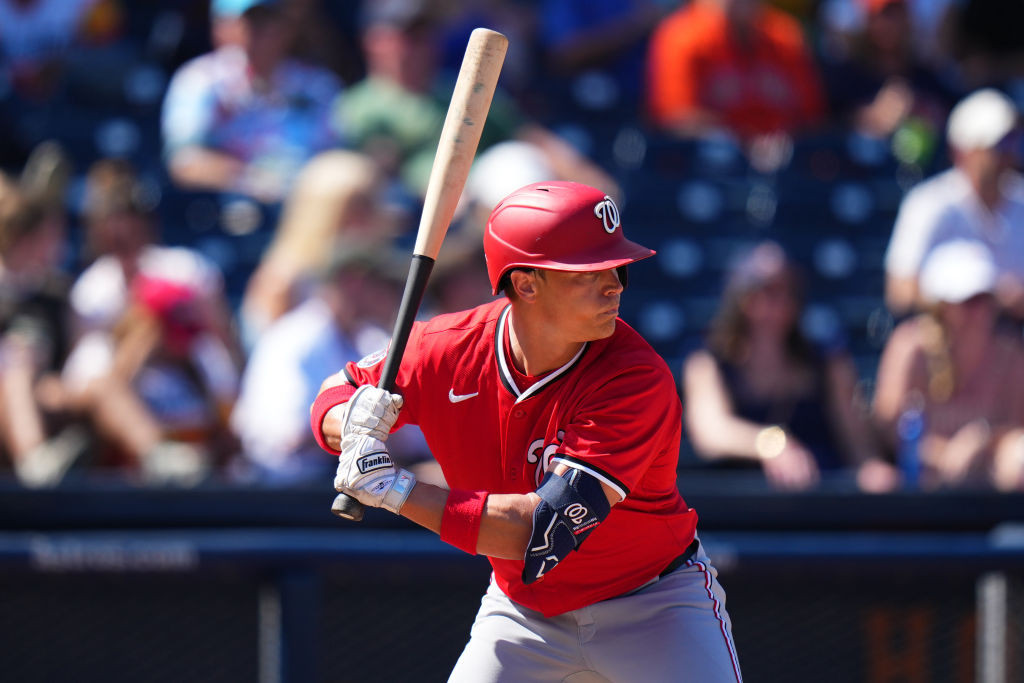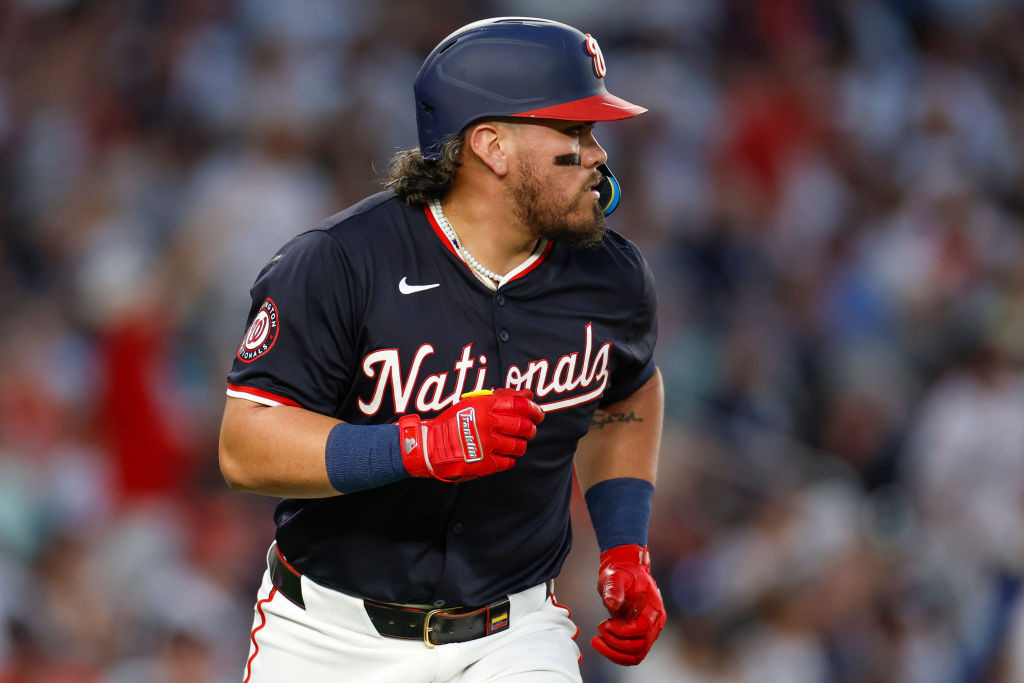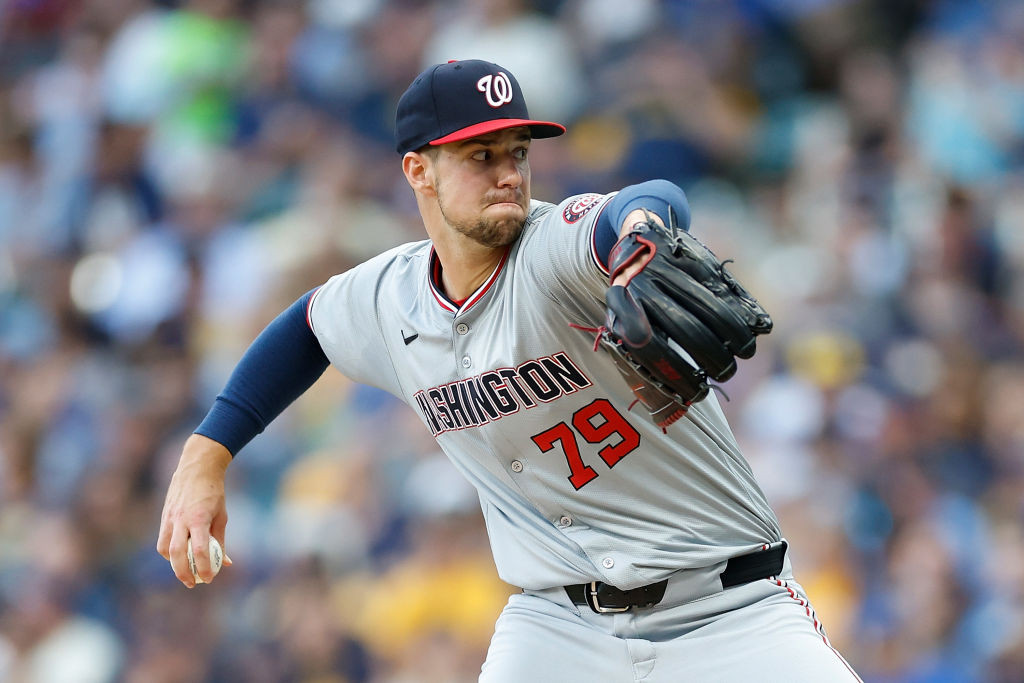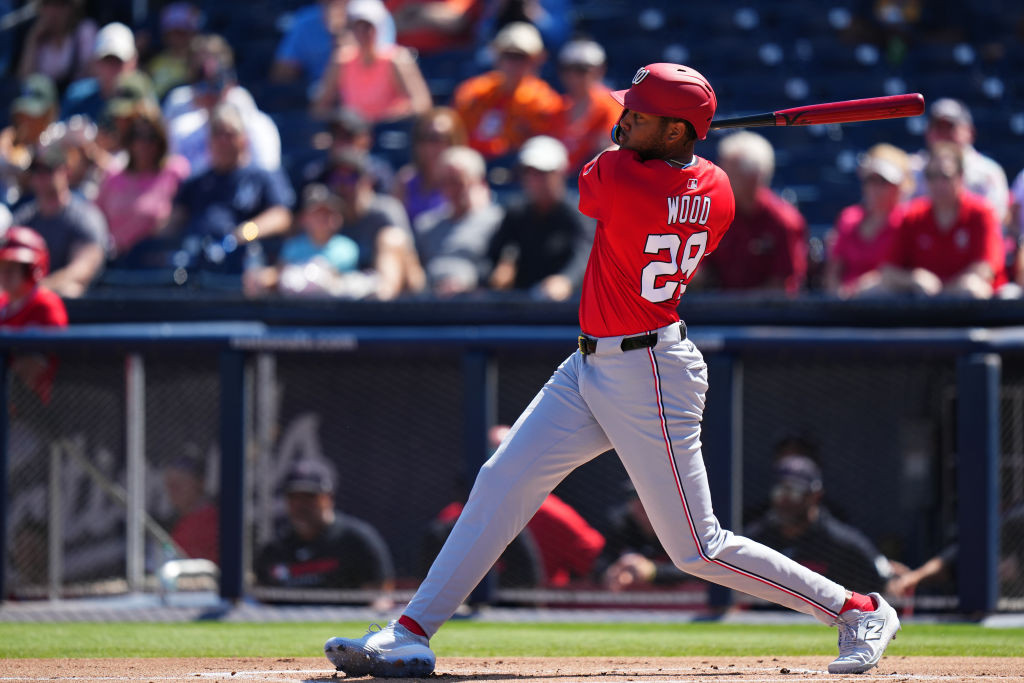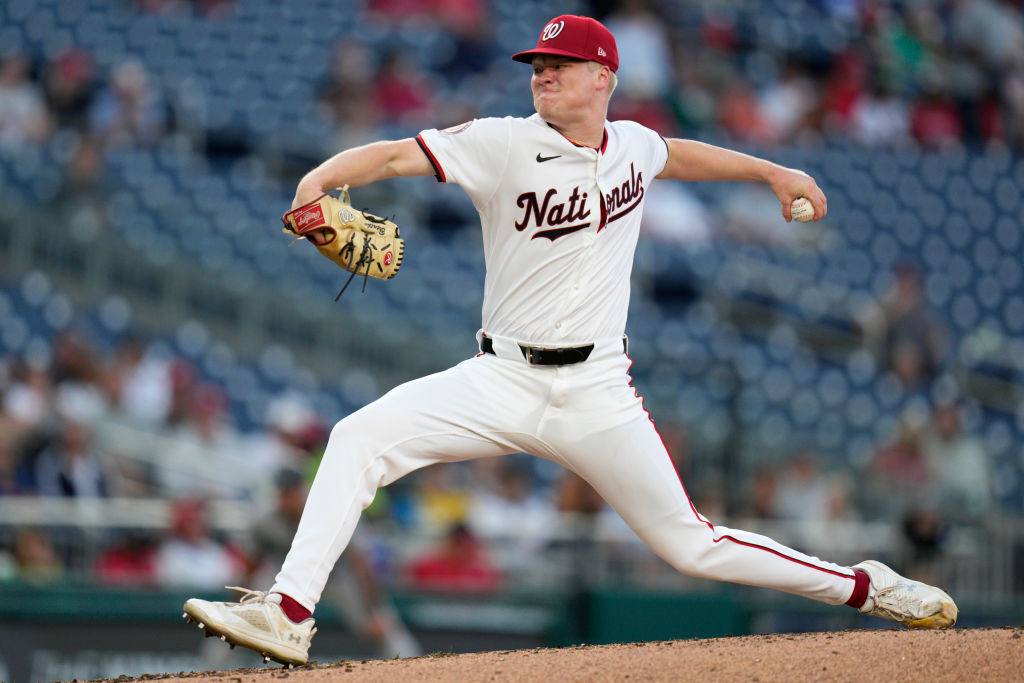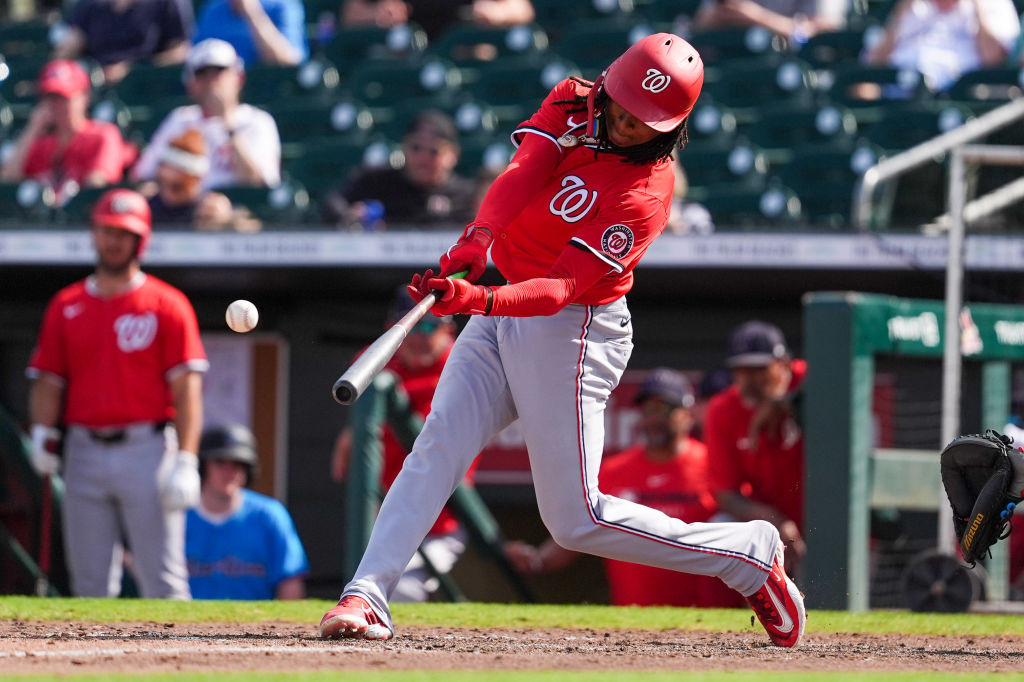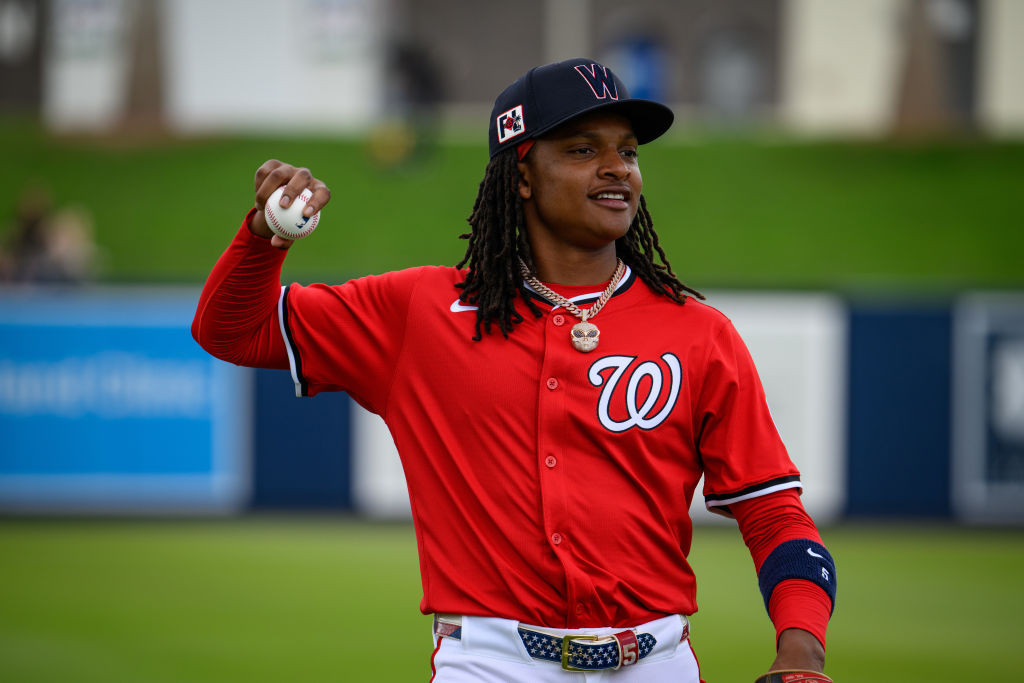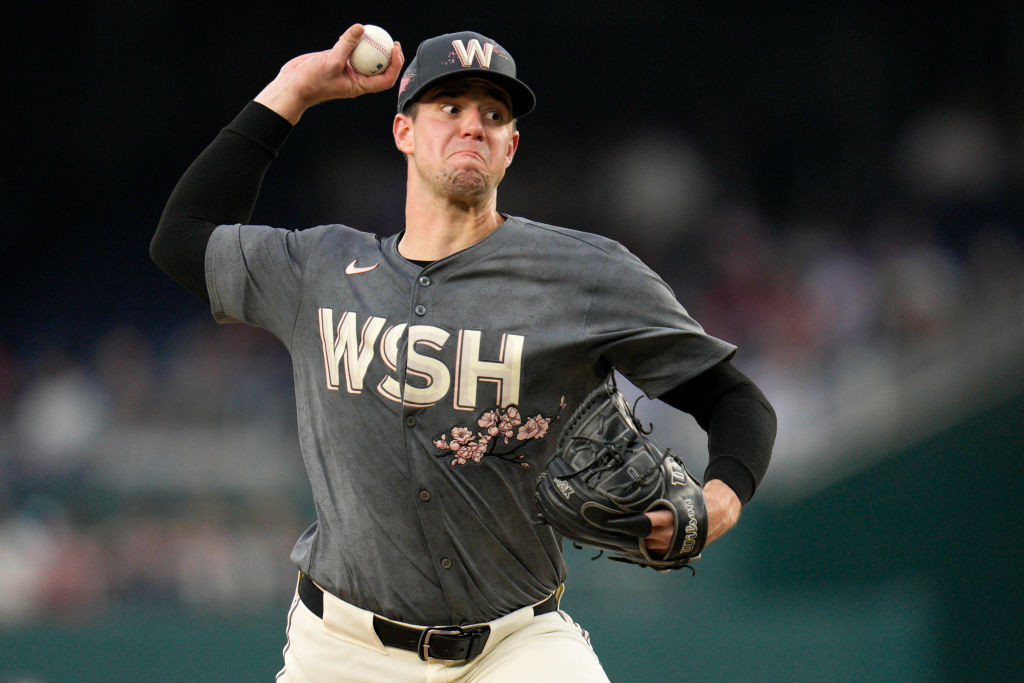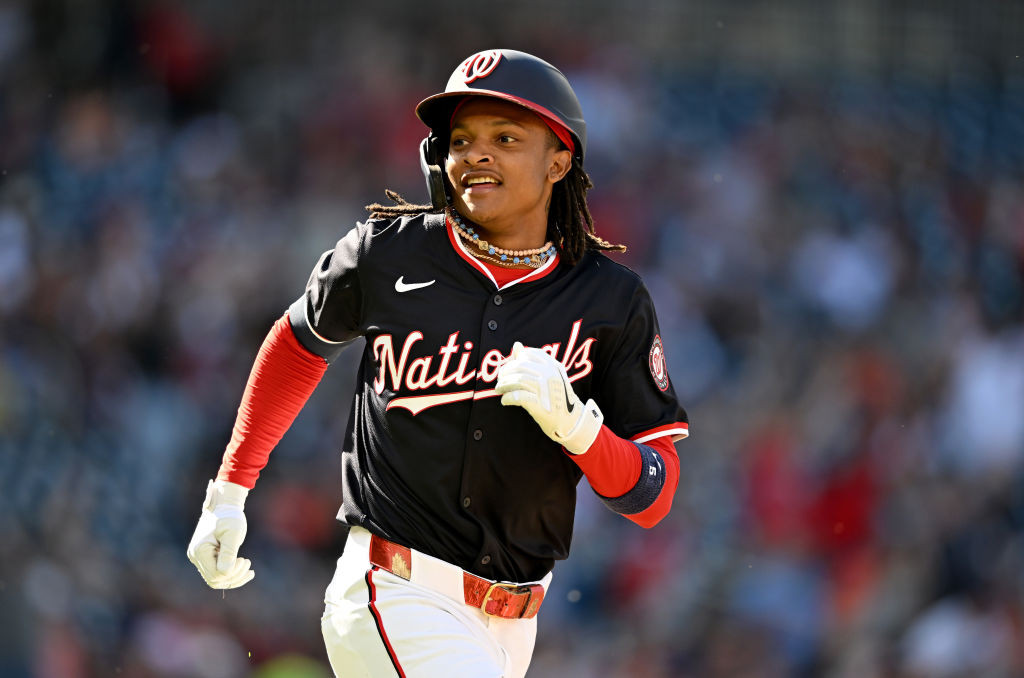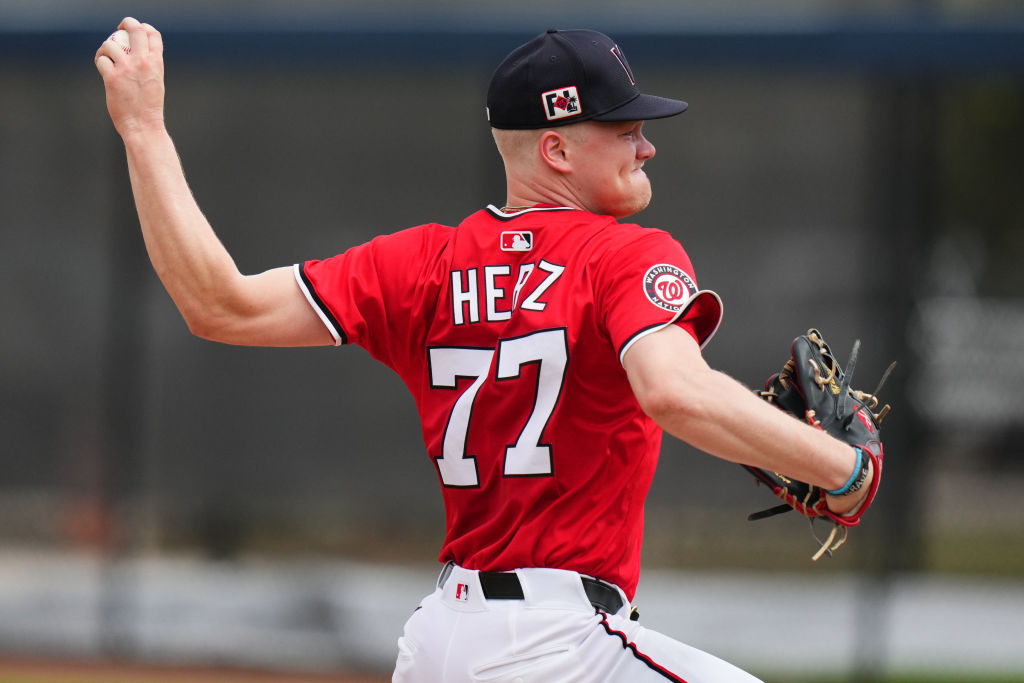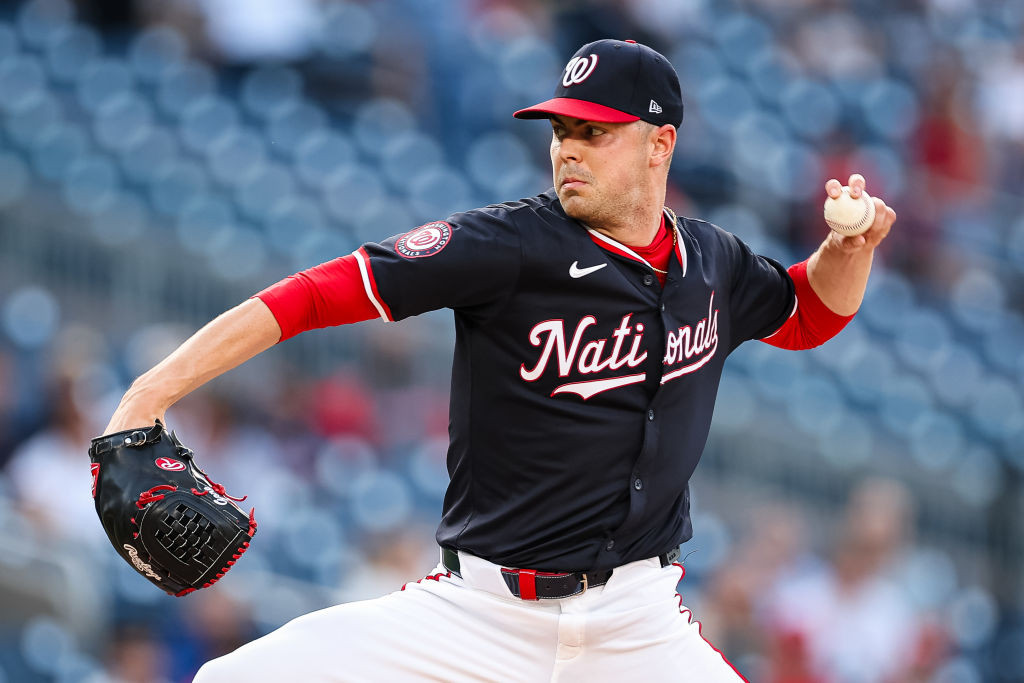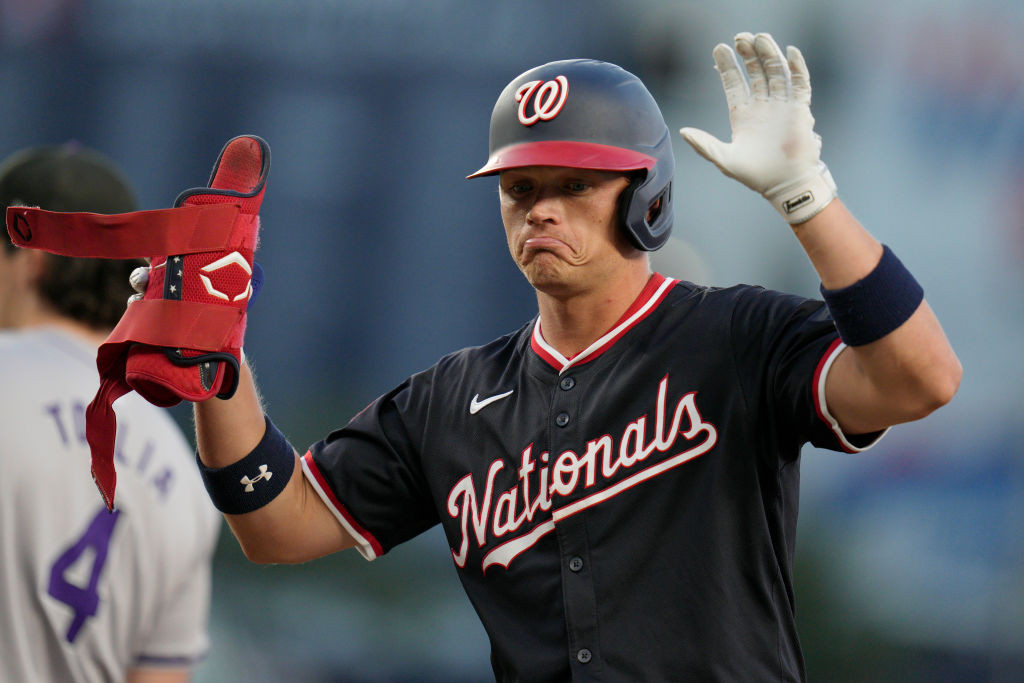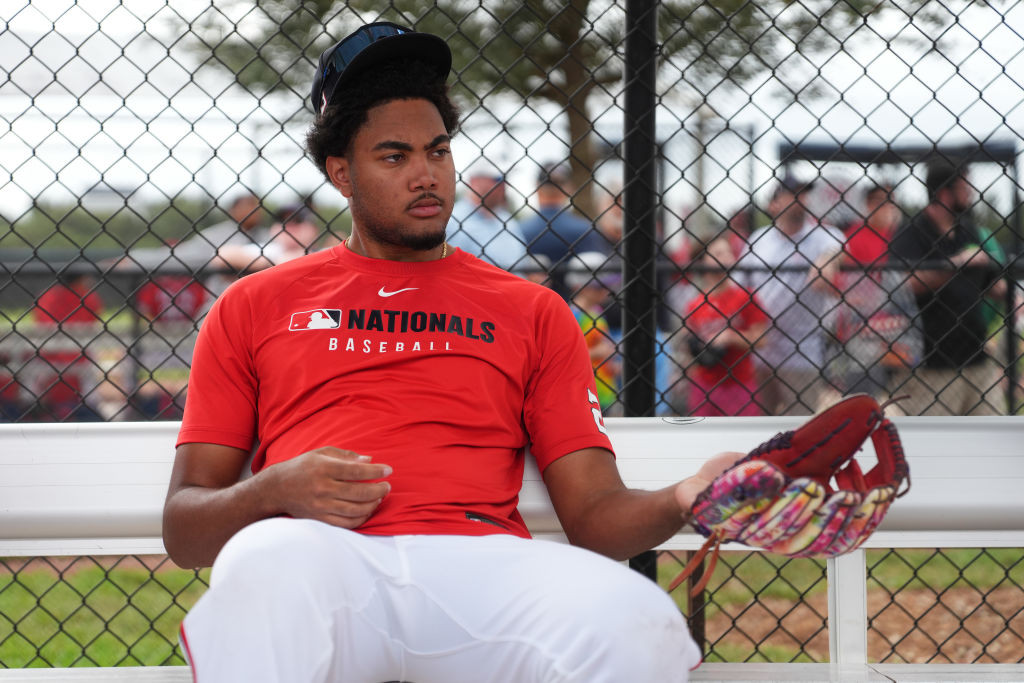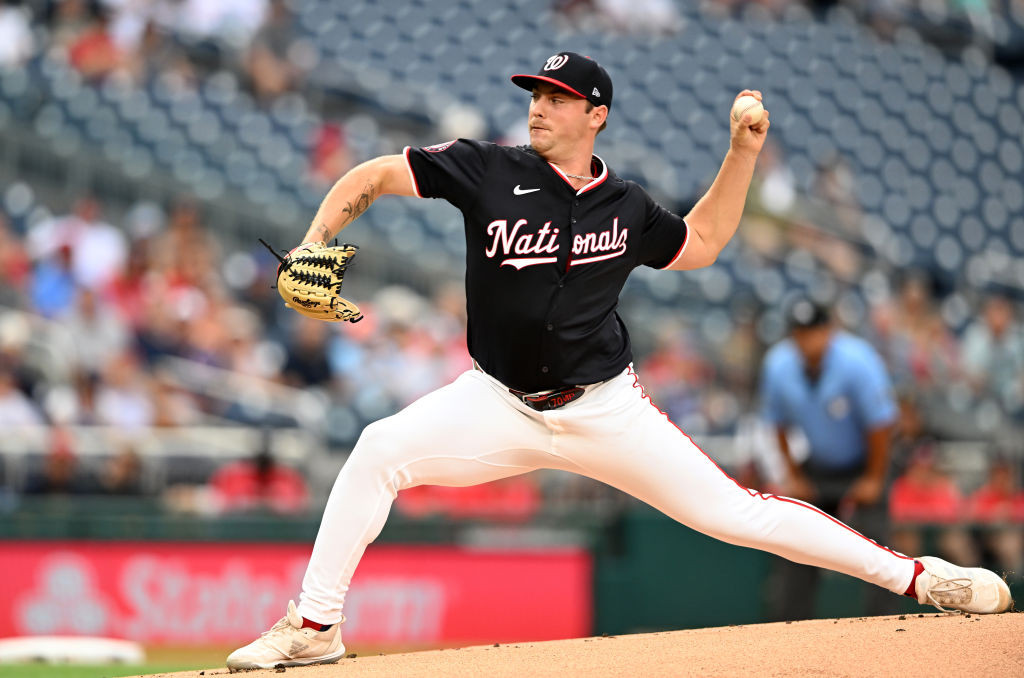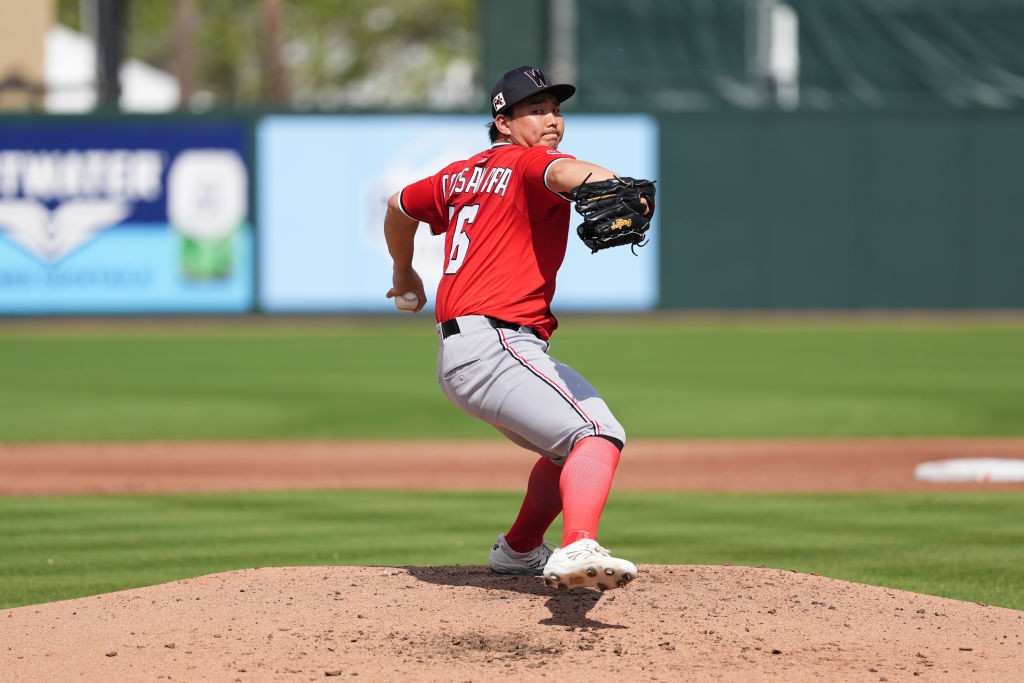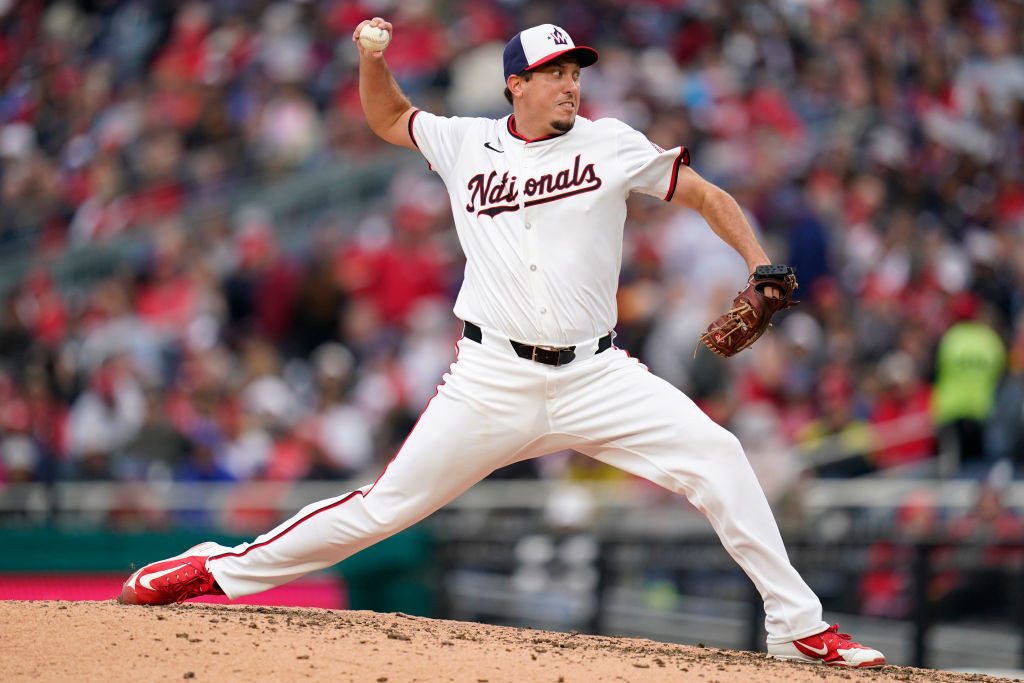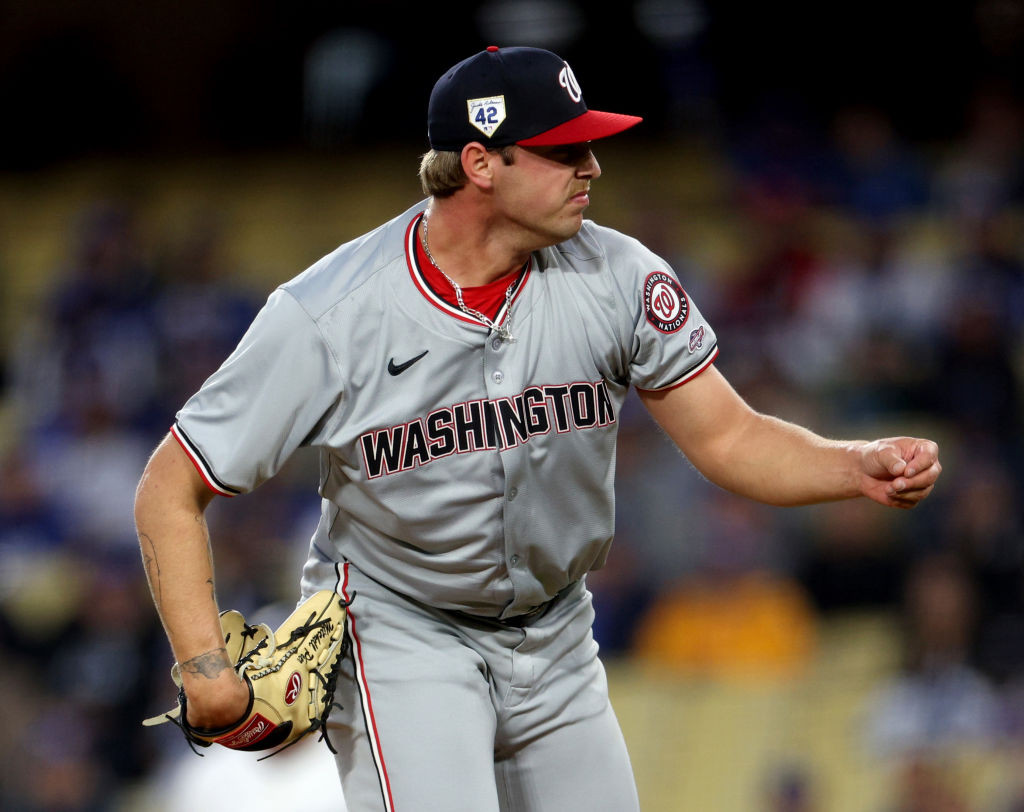WEST PALM BEACH, Fla. – Andrés Chaparro will open the season on the injured list after an MRI today revealed a left oblique strain for the Nationals first baseman/designated hitter.
Chaparro was taking batting practice Friday prior to the Nats’ game against the Braves in North Port when he felt a “jab” in his side on one swing. He immediately left the field with a trainer and was scratched from the lineup.
Chaparro said he’s made some progress over the last 24 hours, but he’s still in some discomfort and was just hoping this afternoon the MRI results didn’t show a significant injury.
“It’s kind of a pulsing thing on my side,” he said, via interpreter Kenny Diaz. “It’s almost like you feel a constant pain that keeps coming and going, just throbbing. I feel a little better than I did yesterday. I’m just working with the trainers and seeing what the recovery looks like.”
Manager Davey Martinez revealed after the game the MRI results, which showed a strain of the left oblique muscle. There's no firm timetable for his return, but Martinez acknowledged Chaparro won't be ready for Opening Day.
WEST PALM BEACH, Fla. – The Nationals are back on their own side of the state after a two-day jaunt to the Gulf Coast. And they’ll stay here until the end of camp, with every remaining game either in West Palm Beach, Jupiter or Port St. Lucie.
Tonight, it’s the Mets coming to town, and they brought some of the big names with them. Yes, Juan Soto made the trip and will bat second tonight against his former team. Pete Alonso, Brandon Nimmo and Jesse Winker are also here, presenting a nice challenge for Mitchell Parker.
Parker seems to have inched ahead in the race for the fifth starter’s job, based mostly on one solid outing Monday (and the struggles of DJ Herz and Shinnosuke Ogasawara) against the Marlins. He’s guaranteed of nothing at this point, but another solid start tonight (especially against that lineup) could help solidify his case.
The guys who played the last two days in Port Charlotte and North Port get tonight off, so the primary names in the lineup are Nathaniel Lowe, Josh Bell, Paul DeJong and Keibert Ruiz. They’ll face Clay Holmes, the former Yankees reliever who recently was named the Mets’ Opening Day starter.
WASHINGTON NATIONALS vs. NEW YORK METS
Where: CACTI Park of the Palm Beaches
Gametime: 6:05 p.m. EDT
TV: None
Radio: None
Weather: Mostly clear, 79 degrees, wind 17 mph right field to left field
NORTH PORT, Fla. – Alex Call believes in himself. Just as any professional athlete does, but maybe ratcheted up just a little extra. It’s what you have to do when you’re an undersized, non-first-round pick from Ball State who has had to earn his way onto every roster he’s ever played on.
“Bottom line, I think I’m a good player and I think I’m capable of putting up good numbers,” he said, “no matter if it’s spring training or during the season.”
Call consistently puts up good-to-great numbers in spring training. He’s played in 83 official Grapefruit or Cactus League games since 2017 with the White Sox, Guardians and now Nationals. His total offensive numbers: a .333/.456/.475 slash line, not to mention way more walks (32) than strikeouts (23).
And he’s up to his old tricks this spring, going 7-for-21 with four doubles, six RBIs and a ridiculous 10-to-1 walk-to-strikeout ratio.
If it feels like Call treats these exhibition games like they’re regular season games, he does.
NORTH PORT, Fla. – Major leaguers usually have to learn how to hit the ball the other way. Some never figure it out and develop reputations as dead-pull hitters.
James Wood has already established his ability to crush the ball to the opposite field in a manner few hitters of any age can. Now the Nationals' young star is learning how to pull it, fully completing his offensive game.
And it was all on display the last two days. After launching a first-inning homer to left Thursday against the Rays, Wood pulled a pair of doubles this afternoon during the Nats’ 5-3 exhibition win over the Braves.
“That’s good,” manager Davey Martinez said. “He’s getting ready in time. He’s not really trying to do a whole lot, which is awesome. His hands, he’s staying through the zone a really long time. To see him turn on balls like that, knowing he can do that, it was great.”
Wood’s homer Thursday came on the first pitch he saw from Tampa Bay’s Shane Baz. His first double today came on the first pitch he saw from Atlanta’s Spencer Schwellenbach, and he drove it to deep right-center, the ball caroming off the wall at CoolToday Park.
NORTH PORT, Fla. – Injuries are the last thing any player wants to experience at this stage of spring training, all the more so for any player battling for a spot on the Opening Day roster.
So when Andrés Chaparro had to be scratched from today’s lineup after experiencing some kind of discomfort during batting practice, the competition for the final spot on the Nationals’ bench may have had a wrench thrown into it.
Chaparro was set to bat fifth and start at first base for the Nats against the Braves, an opportunity for him to continue his torrid spring at the plate and further his case for that spot on the Opening Day roster. The 25-year-old is batting a robust .400 (12-for-30) with two doubles, a homer and five RBIs, though he has also run into several outs on the bases, much to the chagrin of the coaching staff.
Juan Yepez, who is also in the mix for that “26th man” job, will now start at first base in Chaparro’s place, with Stone Garrett taking over his spot in the lineup and serving as designated hitter.
Chaparro and Yepez have a similar player profile, with Yepez having an advantage because of his defensive versatility but a disadvantage because of his lower numbers this spring (6-for-27, one double). Also competing for the job are José Tena (who can play third base, shortstop and second base) and Nasim Nuñez (who excels in the field and on the bases and is batting .458 this spring).
NORTH PORT, Fla. – Hello, for the first time ever, from CoolToday Park, home of the Braves. It’s the first time the Nationals have ever played here, and it’s the first time your humble beat writer has ever been here, which officially completes my lifetime Grapefruit League circuit. I’ve now been to every active spring training site in Florida at least once. What do I win?
The Nats spent the night in a nearby hotel after playing the Rays in Port Charlotte on Thursday. So it’s the same roster of guys here to face Atlanta. They brought a bunch of backups, though, so it’s not the exact same starting lineup.
On the pitching side, this is going to be a bullpen game. It’s Jake Irvin’s day to throw, but he stayed back in West Palm Beach and is facing hitters on a back field. So it’s going to be a parade of relievers this afternoon, starting with a guy who used to be a starter but we recently learned has become a reliever: Jackson Rutledge. The 2019 first round pick faces a formidable lineup, with most of the Braves regulars playing.
If you’ve seen the schedule, you’ve also seen that the Nats are playing a “Spring Breakout” game today in West Palm Beach. That’s the leaguewide showcase for top prospects. Obviously, I can’t be there and here at the same time, so I won’t have any coverage of that game. The good news: They play another breakout game Sunday, and I will be there for that one.
Update: Andrés Chaparro was scratched from the lineup after apparently feeling something wrong during batting practice. Juan Yepez will now play first base, with Stone Garrett now in the lineup as designated hitter.
PORT CHARLOTTE, Fla. – CJ Abrams’ quads appear to be just fine, thank you very much. And the young trio atop the Nationals lineup appears to be primed for some big things this season if Thursday’s performance was a sign of things to come.
With Abrams back playing one day after departing in the first inning with bilateral quadriceps cramps, manager Davey Martinez was able to field his preferred 1-2-3 atop his batting order against the Rays, with Abrams leading off, Dylan Crews batting second and James Wood third.
That trio got the game off to a picture-perfect start: Abrams led off with a single to center, Crews followed with a single to right-center that advanced his teammate to third base and then Wood drove everyone and himself in with a three-run homer to left off Tampa Bay starter Shane Baz.
“With James, we talk about guys on base. I want him to be the guy that drives in runs,” Martinez said. “He jumped on a pitch there right away and hit it a long way.”
Wood is a noted patient hitter, with a keen eye at the plate for such a young player. But the reason Martinez has him batting third in this lineup is precisely for scenarios like Thursday’s opening frame, when he was able to use his tremendous opposite-field power to put a big number on the board with one swing of the bat.
PORT CHARLOTTE, Fla. – The fifth starter competition in Nationals camp has been less a spirited battle and more a war of attrition. One that may leave Mitchell Parker as the last man standing when the team heads north in 10 days.
DJ Herz seemingly had an opportunity to make a case for himself this afternoon against the Rays, but it turns out the Nats planned all along to limit the young left-hander to no more than 60 pitches in response to his diminished velocity this spring.
So, Herz was pulled after three innings and 56 pitches (only 30 of them strikes). He allowed just one run, via a towering homer by Brandon Lowe, but he also surrendered a double and issued two walks while striking out just one batter during an eventual 14-4 drubbing by Tampa Bay. All this while throwing a fastball that topped out at 91 mph. (He averaged 93.5 mph last season.)
“We just battled, just found a way to get outs,” he said. “It might not have been the most efficient, but we found a way to get outs. I think we had planned already it was going to be 60 (pitches); we just cut it.”
One of the brightest spots of the 2024 season after making 19 starts, several of them among the best outings anyone on the team had, Herz has looked less than impressive this spring. Over 9 2/3 total innings, he has allowed nine runs (seven earned) on 10 hits, walking nine while striking out only four.
PORT CHARLOTTE, Fla. – CJ Abrams is back in the Nationals lineup, with no apparent lingering concerns after departing Wednesday’s game in the first inning.
Abrams is leading off and starting at shortstop for this afternoon’s game against the Rays, the first leg of a rare overnight spring training trip for the Nats, who brought most of their regulars for these games in Port Charlotte and North Port (home of the Braves).
The 2024 All-Star led off the bottom of the first Wednesday with a triple into the right field corner, but departed two batters later with cramps in both of his quadriceps muscles. Manager Davey Martinez said at the time he wasn’t overly concerned and that Abrams would be making the road trip regardless.
Sure enough, he’s here and back in his usual role today, provided he makes it through pregame drills with no issues.
“He’s going to do everything and see how it goes,” Martinez said. “But he said he feels fine.”
PORT CHARLOTTE, Fla. – Hello from the Gulf Coast of Florida, the opposite side of the state from where you usually hear from us. The Nationals are making a rare overnight spring training trip, with back-to-back games against the Rays here in Port Charlotte and then the Braves in nearby North Port. Most of the regulars have made the trip and will play in both games before heading back to West Palm Beach on Friday night.
DJ Herz takes the mound for what is arguably an important start for the young lefty. With the race for the fifth starter’s job still wide open, Davey Martinez and Mike Rizzo are just waiting for somebody to step in and seize it. Mitchell Parker made his case with a strong start Monday against the Marlins. Herz now gets his chance to make his own case this afternoon against Tampa Bay.
The Nats lineup includes the starting outfield trio of Alex Call, Jacob Young and Dylan Crews, with James Wood serving as the designated hitter. Luis García Jr. is starting at second base. And CJ Abrams is leading off and starting at shortstop after coming out of Wednesday’s game in the first inning with cramps in both quad muscles.
WASHINGTON NATIONALS vs. TAMPA BAY RAYS
Where: Charlotte Sports Park, Port Charlotte, Fla.
Gametime: 1:05 p.m. EDT
TV: None
Radio: MLB.com (Rays’ feed)
Weather: Sunny, 77 degrees, wind 11 mph out to center field
NATIONALS
SS CJ Abrams
RF Dylan Crews
DH James Wood
3B Paul DeJong
2B Luis García Jr.
LF Alex Call
1B Juan Yepez
CF Jacob Young
C Andrew Knizner
WEST PALM BEACH, Fla. – The conversation happened a few weeks ago and was the type of conversation that doesn’t always go over well with the player involved.
The Nationals used their first round pick in 2019 on Jackson Rutledge because they believed he could be a frontline starting pitcher for them for a long time. Now, nearly six years later, they were telling the right-hander they wanted to convert him into a reliever, a tacit acknowledgement the original plan never came to fruition.
So, how did Rutledge take that news from manager Davey Martinez earlier this spring?
“I’m here to just help the team win,” he said. “Obviously, we’ve signed a few guys since that conversation, but it’s kind of like, we need bullpen arms. They’re really important to winning games, a lot of times even more important sometimes than a starter. I feel like if I can be a guy that keeps us in a lot of games, can pitch long innings, pitch short innings, whatever it may be, I feel like I can help the team get a bunch of wins this year.”
So it was that Rutledge officially made the transition from a guy who tries to throw as many innings as possible every five days to a guy who tries to throw one or two innings at a time every two or three days.
WEST PALM BEACH, Fla. – The sight of CJ Abrams racing around the bases for a leadoff triple in the bottom of the first today was a beautiful thing for the Nationals. The sight of the All-Star shortstop walking off the field and seeking out a trainer two batters later was the last thing anyone wanted to see.
By all accounts, it doesn’t appear to be anything serious. Abrams said both of his quadriceps muscles cramped up during the leadoff triple, according to manager Davey Martinez, who suggested he had no reason to be concerned following a 9-3 exhibition victory over the Astros.
“I didn’t want to take any chances,” Martinez said. “He came in and got treatment. I haven’t seen (director of athletic training Paul Lessard) yet, but I’ll check up on him. He should be OK. They said they did some tests, and it was fine. He just cramped up.”
Abrams looked good on his 270-foot trek around the bases after he ripped a pitch from Astros left-hander Brandon Walter down the right field line to open the bottom of the first, coasting into third with ease. He remained there as Dylan Crews grounded out to the mound and as James Wood struck out for the inning’s second out.
It was after that strikeout that Abrams could be seen hunching over, dealing with some kind of discomfort. Martinez signaled from the dugout for Abrams to come out of the game, and he walked all the way back, greeted at the steps by Lessard.
WEST PALM BEACH, Fla. – With 11 days to go in spring training, seven starting pitchers competing for five jobs and a rare, cross-state, overnight trip looming, mapping out the Nationals’ rotation schedule is no simple task for manager Davey Martinez and pitching coach Jim Hickey. They finally settled on a plan this morning, one that takes all of those factors into consideration.
MacKenzie Gore is starting this afternoon’s game against the Astros. It’s only his second official start of the spring, but the left-hander has still been throwing every five days, whether on a back field against minor leaguers or in a simulated game against teammates.
While Gore faces Houston inside CACTI Park of the Palm Beaches, Trevor Williams is facing minor leaguers outside the stadium. The veteran right-hander, who Martinez confirmed this week will open the season in the rotation, has already made three Grapefruit League appearances.
DJ Herz will take the long bus ride from West Palm Beach to Port Charlotte on Thursday morning and then start that afternoon’s game against the Rays. Herz, who is competing for the fifth starter’s job, has looked shaky so far in three Grapefruit League outings, walking seven while striking out only three in 6 2/3 innings.
Jake Irvin’s turn comes up Friday, but the right-hander will stay back in West Palm Beach and face minor leaguers instead of traveling to North Port to face the Braves. That makes Friday’s game a bullpen game for the Nats, with a host of relievers set to pitch one or two innings a piece.
WEST PALM BEACH, Fla. – The Nationals embark on a rare spring training road trip Thursday, with back-to-back games on the other side of the state. But first up is one more home game, this one against their fellow tenants at CACTI Park of the Palm Beaches.
MacKenzie Gore makes what’s actually only his second official start of the spring. The left-hander has still been getting his full workload in, throwing on back fields and in simulated games due to scheduling and the need to get other guys innings in real games. He’s good to go up to five innings or 80 pitches today, per Davey Martinez. And though nothing has officially been said yet, Gore remains on a schedule that lines up with Opening Day.
We’ll see plenty of regulars in the lineup as well, with CJ Abrams, Dylan Crews and James Wood again batting 1-2-3 against Astros left-hander Brandon Walter. Among the potential relievers on today’s list are Jose A. Ferrer, Colin Poche and Eduardo Salazar.
WASHINGTON NATIONALS vs. HOUSTON ASTROS
Where: CACTI Park of the Palm Beaches, West Palm Beach
Gametime: 1:05 p.m. EDT
TV: None
Radio: MLB.com (Astros’ feed)
Weather: Sunny, 77 degrees, wind 5 mph in from right field
NATIONALS
SS CJ Abrams
RF Dylan Crews
LF James Wood
1B Nathaniel Lowe
DH Josh Bell
3B Paul DeJong
C Keibert Ruiz
2B Amed Rosario
CF Jacob Young
WEST PALM BEACH, Fla. – There are 11 days to go in spring training, 12 exhibition games left to play if you count the March 24 finale against the Orioles in D.C. So the Nationals are about to enter crunch time, when decisions that have been looming since mid-February suddenly come to a head.
There haven’t been that many decisions already made this camp. The players who have been cut so far were mostly expected to be cut all along. That leaves 48 players remaining in big league camp: 38 of them from the 40-man roster, with another 10 non-roster invitees still participating with the others.
Suffice it to say, there’s still a lot of work to be done to trim 48 down to 26 before Opening Day.
Let’s take a look, then, at the current state of the spring roster and try to figure out who’s sitting pretty, who still has a chance and who’s probably on the outside looking in …
CATCHERS (4)
Sitting pretty: Keibert Ruiz
Still has a chance: Riley Adams, Drew Millas
Outside looking in: Andrew Knizner
Comment: We know Ruiz is still the No. 1 catcher, and to his credit, he’s had a very good spring at the plate so far (7-for-24, three homers). There’s still a big question who will back him up when the season begins. Adams has hit two homers, but is just 3-for-13 overall and has had some shaky moments behind the plate. Millas, though, is 1-for-16 (with four walks) and surprisingly hasn’t looked great defensively. Knizner has experience with the Cardinals and perhaps could force his way into the conversation, but he’s just 2-for-15 at the plate himself.
WEST PALM BEACH, Fla. – The Nationals are off today, but that doesn't mean your trusty beat writer is off. There's plenty still to discuss about the first month of camp and what's still to come over the final two weeks.
This has been an eventful spring to date. We've seen the Nats sign four players who are likely to make the Opening Day roster (Kyle Finnegan, Lucas Sims, Colin Poche, Paul DeJong). We've seen James Wood come back from a minor quad injury and tear the cover off the ball. We've seen Dylan Crews, CJ Abrams, Luis García Jr. and Robert Hassell III all deliver big at the plate. And we've seen some mixed results from the pitching staff, especially those trying to win the fifth starter's job.
Surely, you've got questions you'd like answered, so let's use this opportunity today to delve into a bunch of topics. One important caveat: If you could please avoid questions about the Nats' current and future TV situation, understanding I really can't provide any insight into that subject, I would greatly appreciate it.
JUPITER, Fla. – This was pretty much assumed all along, but Davey Martinez confirmed it this morning: There’s only one open spot in the Nationals’ Opening Day rotation. The precise order has yet to be announced, but MacKenzie Gore, Jake Irvin, Michael Soroka and Trevor Williams will begin the season as the team’s top four starters.
Which leaves one more job for a trio of young left-handers: DJ Herz, Mitchell Parker and Shinnosuke Ogasawara. And what will the Nats base their final decision on?
“I want to see these guys – it’s going to happen during the season sometimes – in high-leverage situations, how they’re going to handle it,” Martinez said. “And it’s about throwing strikes, pounding the strike zone.”
So consider what Parker did this afternoon in what wound up a 9-9 tie with the Marlins a much-needed step in the right direction, all the more so after Ogasawara labored once again later in the evening. Though Parker gave up a pair of solo homers with a stiff wind blowing out at Roger Dean Chevrolet Stadium, he otherwise was quite efficient, needing only 48 pitches (33 of them strikes) to complete four innings.
“Just being able to get out of the innings without throwing a lot of pitches was definitely a good thing,” said the lefty, who threw an additional 16 pitches in the bullpen afterward to build up his total count. “That’s what we did good at last year. I’m hoping to carry that over to this year.”
WEST PALM BEACH, Fla. – Who’s ready for some more baseball? The venues have switched, but the teams remain the same as the Nationals and Marlins play the second half of their day-night, split-squad doubleheader, this time at the friendly confines of CACTI Park of the Palm Beaches.
With Mitchell Parker having looked pretty sharp in today’s matinee, there’s some increased pressure on Shinnosuke Ogasawara to perform better tonight. The Japanese left-hander hasn’t blown anyone’s socks off so far in his first three spring training starts. At some point as we move into mid-March, results do start to matter.
The top of the lineup features the big boys, headlined by the enticing 1-2-3 of CJ Abrams, Dylan Crews and James Wood. Luis García Jr. and Jacob Young are also starting tonight against Marlins right-hander Cal Quantrill.
WASHINGTON NATIONALS (ss) vs. MIAMI MARLINS (ss)
Where: CACTI Park of the Palm Beaches, West Palm Beach
Gametime: 6:05 p.m. EDT
TV: None
Radio: 106.7 FM, MLB.com
Weather: Rain ending, 73 degrees, wind 21 mph out to right field
NATIONALS
SS CJ Abrams
RF Dylan Crews
LF James Wood
DH Andrés Chaparro
2B Luis García Jr.
3B Amed Rosario
1B Juan Yepez
C Riley Adams
CF Jacob Young
WEST PALM BEACH, Fla. – For nearly a month, Derek Law has been at Nationals camp. He’s been in the clubhouse. He’s been on the practice fields. He’s been healthy. And until today he hadn’t participated in anything that resembled a game situation.
“I’ve been super antsy,” the reliever said. “These guys get here, and I’m just playing super-light catch, and these guys are ripping it like that. You just get the itch, because everybody’s having fun. You want to be a part of it. It almost feels like a rehab, but I’m not.”
Law isn’t rehabbing from any injury. He’s simply been on a pre-planned, delayed throwing program as the Nats attempt to get him ready for Opening Day without using up too many bullets in spring training.
One year after becoming the Nationals’ first reliever to total 90 innings since Tyler Clippard in 2010, three innings shy of Saul Rivera’s club record from 2007, Law is setting the bar high. He wants to be available anytime Davey Martinez needs him. Which means he wants to enter the season with a full tank, while still finding a way to adequately prepare.
So that meant sitting back and watching everyone else fully participate from day one of spring training while he waited for his time to come.
JUPITER, Fla. – The Nationals are Marlins are going to see a lot of each other today. These two teams are playing a split-squad, day-night, two-city doubleheader. They’ll meet again tonight at CACTI Park of the Palm Beaches. First up, though, it’s a matinee at Roger Dean Chevrolet Stadium.
Mitchell Parker finally gets to make his first start of the spring after pitching in relief up to this point. The left-hander needs to start building up his pitch count, and he needs to start making his case for the wide-open final spot in the Opening Day rotation. He can set the tone with a solid outing this afternoon, putting pressure on Shinnosuke Ogasawara (who starts the nightcap).
The Nationals who made the short trip to Jupiter for this one are going to have to face one of the best arms in the game in Sandy Alcantara. Best of luck to Nathaniel Lowe, Keibert Ruiz, Josh Bell, Paul DeJong and Co. as they try to get something going at the plate against the Marlins ace.
WASHINGTON NATIONALS (ss) vs. MIAMI MARLINS (ss)
Where: Roger Dean Chevrolet Stadium, Jupiter
Gametime: 1:10 p.m. EDT
TV: None
Radio: MLB.com (Marlins’ feed)
Weather: Chance of rain late, 85 degrees, wind 23 mph out to center field
NATIONALS
RF Alex Call
1B Nathaniel Lowe
C Keibert Ruiz
DH Josh Bell
3B Paul DeJong
CF Robert Hassell III
LF Daylen Lile
SS Nasim Nuñez
2B Trey Lipscomb




-1745819772711.png)

